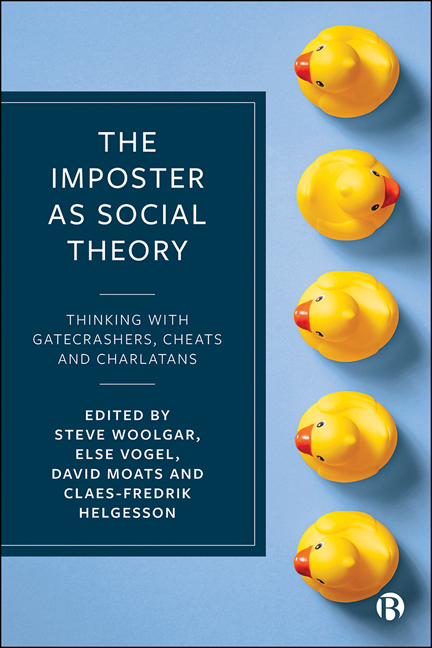Book contents
- Frontmatter
- Contents
- List of Figures and Boxes
- Notes on Contributors
- Preface
- 1 Thinking with Imposters: The Imposter as Analytic
- 2 The Desire to Believe and Belong: Wannabes and Their Audience in a North American Cultural Context
- 3 A Menagerie of Imposters and Truth-Tellers: Diederik Stapel and the Crisis in Psychology
- 4 Learning from Fakes: A Relational Approach
- 5 Imitations of Celebrity
- 6 Natural Imposters? A Cuckoo View of Social Relations
- 7 Conjuring Imposters: The Extraordinary Illusions of Mundanity
- 8 States of Imposture: Scroungerphobia and the Choreography of Suspicion
- 9 The Face of ‘the Other ’: Biometric Facial Recognition, Imposters and the Art of Outplaying Them
- 10 Faking Spirit Possession: Creating ‘Epistemic Murk ’ in Bahian Candomblé
- 11 The Guerrilla’s ID Card: Flatland against Fatland in Colombia
- 12 Good Enough Imposters: The Market for Instagram Followers in Indonesia and Beyond
- 13 Thinking beyond the Imposter: Gatecrashing Un/Welcoming Borders
- 14 Postscript: Thinking with Imposters – What Were They Thinking?
- Index
6 - Natural Imposters? A Cuckoo View of Social Relations
Published online by Cambridge University Press: 22 December 2021
- Frontmatter
- Contents
- List of Figures and Boxes
- Notes on Contributors
- Preface
- 1 Thinking with Imposters: The Imposter as Analytic
- 2 The Desire to Believe and Belong: Wannabes and Their Audience in a North American Cultural Context
- 3 A Menagerie of Imposters and Truth-Tellers: Diederik Stapel and the Crisis in Psychology
- 4 Learning from Fakes: A Relational Approach
- 5 Imitations of Celebrity
- 6 Natural Imposters? A Cuckoo View of Social Relations
- 7 Conjuring Imposters: The Extraordinary Illusions of Mundanity
- 8 States of Imposture: Scroungerphobia and the Choreography of Suspicion
- 9 The Face of ‘the Other ’: Biometric Facial Recognition, Imposters and the Art of Outplaying Them
- 10 Faking Spirit Possession: Creating ‘Epistemic Murk ’ in Bahian Candomblé
- 11 The Guerrilla’s ID Card: Flatland against Fatland in Colombia
- 12 Good Enough Imposters: The Market for Instagram Followers in Indonesia and Beyond
- 13 Thinking beyond the Imposter: Gatecrashing Un/Welcoming Borders
- 14 Postscript: Thinking with Imposters – What Were They Thinking?
- Index
Summary
Introducing the common cuckoo: ‘the quintessential cheat’?
Perched on a branch, a cuckoo hen watches in silence, waiting for a robin to leave her nest. Once the robin leaves to forage, the cuckoo approaches its nest, and crouches amid the robin's eggs. Within seconds the cuckoo lays its egg and flies off. In colour the cuckoo's egg approximates that of the robin. The robin soon returns to resume brooding her clutch. As far as we can tell, she does not react to the appearance of an additional egg now in her nest. On hatching, the robin raises the cuckoo nestling alongside her biological offspring. The cuckoo chick outcompetes some of the nestling robins. This results in the robin chicks’ death by starvation, and the ejection of their corpses from the nest. Upon sexual maturity, the surviving offspring – cuckoo and robins alike – go on to repeat this ecological cycle.
Ecologists describe this behaviour as brood parasitism. Cuckoos are a diverse family of 141 species ranging across all continents bar Antarctica. Not all cuckoo species are brood parasites. Those that are lay their eggs in the nests of other birds. Their eggs typically exhibit morphological features resembling those of the host, as we described with the robin. Seemingly none the wiser, the host birds rear the cuckoos’ offspring, often to the demise of their biological offspring. By mimicking host species egg morphology (and in some cases consuming the host bird's egg; Fromme, 2018) the cuckoo reproduces without engaging in parental care. In this way, cuckoo behaviour conjures the idea of imposture in the most intimate of contexts.
In the opening vignette, we tried to depict the cuckoo's actions in purely descriptive terms. But we found it took some considerable effort to avoid using terms like ‘sneak’, ‘invade’ or ‘cheat’ to refer to the events transpiring in the nest. The fact that purposive clinical detachment is difficult to maintain while writing about the nature of brood parasitism is noteworthy. As we discuss in this chapter, cuckoos’ brood-parasitic lifestyles are entangled with human conceptions of imposture. Indeed, human culture is littered with a variety of potent references to cuckoos’ nesting practices. Among these images, we are concerned with the notion of imposture that cuckoos’ brood-parasitic lifestyles evoke.
- Type
- Chapter
- Information
- The Imposter as Social TheoryThinking with Gatecrashers, Cheats and Charlatans, pp. 127 - 146Publisher: Bristol University PressPrint publication year: 2021



